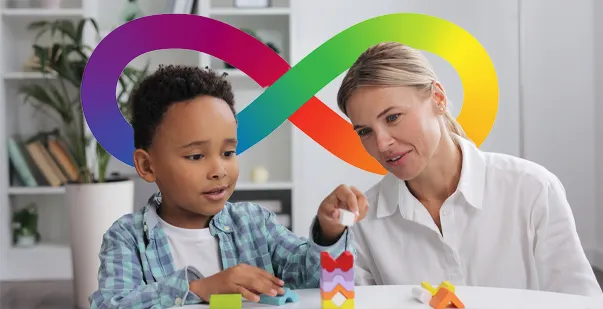April marks Autism Acceptance Month, a powerful reminder that education should celebrate every kind of mind. According to Autism Speaks, 1 in 36 children in the U.S. is diagnosed with autism spectrum disorder (ASD). This creates inclusive learning classrooms which are the need of the hour.
Yet, for many autistic students, the classroom can feel more like a battlefield than a place to grow. Sensory overload, communication barriers, and rigid teaching methods often stand between them and the opportunities they deserve.
But the story doesn’t end there. In fact, it’s only just beginning.
Across the country, educators are redefining what inclusive teaching looks like. A study published by Taylor and Francis shows that schools using Universal Design for Learning (UDL) principles see a noticeable rise in student engagement and performance, not just for autistic learners but for everyone in the classroom. Because when we build systems that work for those who are most overlooked, we raise the bar for all. Let’s find out more below.
Read More: A Guide to Continuing Education for Teachers
Why Inclusion Matters for Autistic Students
Inclusive education for autistic students has been shown to lead to academic gains, including better performance on standardized assessments, Individualized Education Program (IEP) goals, classroom grades, behaviors, and motivation for learning. Every child deserves not just a seat in the classroom but a space where they are seen, supported, and given the chance to thrive. For autistic students, inclusion is more than physical presence; it’s about creating learning environments that recognize and nurture their unique strengths.
While traditional classrooms can often feel overwhelming without the right support, inclusive education is changing the game, opening doors to richer learning, deeper connection, and long-term success.
Boosts Learning and Engagement
Research published in ResearchGate reveals that when autistic students are supported with structured routines, visual aids, and differentiated instruction, they feel safer, more focused, and more engaged. These strategies don't just benefit autistic learners—they elevate the classroom experience for everyone, encouraging a more flexible, responsive approach to education.
Encourages Social Growth
For many autistic students, social interactions can be challenging. But inclusive classrooms provide a natural, safe space to develop these key skills. It has been shown to enhance social development in students with autism spectrum disorders (ASD), promoting their socialization and peer interactions. Through peer mentoring, structured group activities, and clearly defined social expectations, autistic students can build meaningful relationships, confidence, and communication skills that serve them far beyond the classroom.
Reduces Stigma and Promotes Acceptance
Exclusion often leads to misconceptions about autism. When students learn alongside their autistic peers, they develop empathy, patience, and a better understanding of neurodiversity. This fosters a culture of acceptance and respect, helping break down stereotypes.
Prepares Autistic Students for Life Beyond School
Inclusive education helps autistic students develop independence and adaptability, skills crucial for higher education, employment, and daily life. Experiencing a supportive and accommodating school environment early on allows them to navigate the world with greater confidence.
Autism-Friendly Teaching Strategies for Inclusive Classrooms
Creating an inclusive classroom isn’t about ticking a checkbox—it’s about showing up for autistic students in ways that matter. Traditional teaching? Often one-size-fits-none. But when you embrace autism-friendly strategies, you unlock real engagement, reduce barriers, and create a learning space where every student can thrive, not just survive. In fact, implementing autism-friendly teaching strategies in inclusive classrooms has been associated with significant improvements in academic performance and social interactions for students with autism spectrum disorders.
Here’s how to do it right:
Read More: Transforming Education: Why Classroom Conversations Are Key to Effective Learning?
1. Establish Clear and Predictable Routines
Let’s be real: chaos doesn’t help anyone, but for autistic students, it can be paralyzing. Use visual schedules, transition cues, and consistent daily rhythms to give students a sense of safety and control. And when change becomes inevitable? A little heads-up and a calming strategy go a long way. Here are some easy steps to incorporate:
Create a Visual Schedule – Use pictures or charts to show the daily routine so students know what to expect.
Be Consistent – Stick to the same routine every day to reduce anxiety and confusion.
Give Warnings Before Transitions – Let students know a few minutes in advance when it’s time to switch activities.
Use Timers – Set a timer to help students understand when an activity will start or end.
Provide Clear Instructions – Give simple, step-by-step directions for tasks to help students stay focused.
Prepare for Changes – If there’s an unexpected change, explain it calmly and clearly beforehand.
2. Use Visual Supports and Aids
Words alone don’t always cut it. Many autistic students are visual learners, which means pictures, charts, diagrams, and icons are gold. Incorporating visual schedules has been shown to improve classroom behavior and engagement in students with autism spectrum disorder (ASD). A study found that 43.2% of parents of autistic children use visual schedules to enhance daily routines. Tools like social stories and visual step-by-step guides boost comprehension, lower frustration, and support independence. It’s not “extra.” It’s required.
3. Create a Sensory-Friendly Classroom Environment
Fluorescent lights. Loud chatter. Scratchy carpet. To a sensory-sensitive student, that’s a chaotic scenario. Create a sensory-friendly classroom with softer lighting, reduced noise, and sensory tools (think: fidget objects, headphones, quiet corners). When students can self-regulate, learning stops feeling like a war zone.
4. Implement Flexible Teaching Methods
Learning isn’t one lane. Some students need hands-on activities. Others thrive with visuals or verbal cues. Embrace multimodal teaching and offer options for how work gets done—oral, written, illustrated, typed, signed, or sung. Flexibility isn’t lowering standards; it’s raising access.
5. Foster Clear and Supportive Communication
Communication can be tough for autistic students, so make it easier. Use short, direct sentences. Give extra processing time. Pair your words with visuals. And if students need AAC devices or written instructions, make it normal, not notable. Communication comes in many forms. Honor them all.
6. Encourage Peer Support and Social Interaction
Autonomy is power. Give students choices—where they sit, how they learn, what they create. More importantly, teach self-advocacy. Whether through words, writing, or gestures, students should feel safe expressing their needs. It’s not about “making it easier”—it’s about making it fair.
7. Offer Choices and Encourage Self-Advocacy
Giving students choices in their learning empowers them to express their preferences and build independence. Offering options in assignments, seating arrangements, or break times fosters autonomy. Encouraging students to communicate their needs—whether through speech, writing, or gestures—helps them gain confidence in advocating for themselves in and outside the classroom.
8. Provide Positive Reinforcement and Strength-Based Learning
Enough with deficit-focused thinking. Focus on what students do well. Reinforce effort, progress, and moments of growth. Better yet—bring their interests into lessons. If they’re into trains, cats, or anime, use that to fuel engagement. Here are some ideas:
Praise Efforts, Not Just Results – Reinforce progress with positive feedback.
Use Visual Supports – Help with instructions and expectations.
Incorporate Interests into Lessons – Engage with preferred activities.
Set Achievable Goals – Break tasks into manageable steps
9. Collaborate with Parents and Specialists
Teachers don’t have to do this alone. Parents, therapists, and support staff are your allies. Stay in sync. Share insights. Create consistent strategies across environments. A student’s success doesn’t just happen in your classroom—it’s a team effort.
10. Promote a Culture of Understanding and Acceptance
Inclusion isn’t just a strategy—it’s a culture. Read books, lead discussions, and design activities that highlight neurodiversity. Help all students understand and respect different ways of thinking and being. The more they understand, the kinder they become—and the stronger your classroom community gets.
Best Practices for Fostering Classroom Inclusivity
Creating an inclusive classroom requires a culture of respect, understanding, and support for all students, including those with autism. By fostering an environment where differences are valued, teachers can ensure that every student feels safe, accepted, and empowered to succeed.
Read More: Spring Break for Teachers: How Educators Can Recharge & Upskill
1. Cultivate an Empathetic and Understanding Classroom Culture
Inclusion begins where empathy lives. Want students to respect and support their autistic peers? Then, make neurodiversity part of the conversation. Use books, videos, and classroom discussions that normalize differences instead of sidelining them. Don’t wait for a “teachable moment”—create one. The more openly kids talk about what makes them unique, the more they grow into compassionate, accepting humans.
2. Encourage Peer Support and Collaboration
Socializing isn’t one-size-fits-all. For autistic students, unstructured peer interaction can feel like being tossed into the deep end. Here comes peer support systems, buddy programs, and group activities that actually have structure. Initiatives like the Community Autism Peer Specialist (CAPS) program prove that when you teach neurotypical students to lead with kindness and patience, relationships flourish.
Because when you build social support into the classroom, you're not just helping autistic students—you’re training the whole class to be better humans.
3. Adapt Classroom Policies for Inclusivity
Let’s be real: traditional classroom rules don’t always cut it for autistic students. Research from the National Library of Medicine shows that control over sensory input helps boost focus and reduce stress. So, what does that mean in practice?
Flexible classroom policies. Think: movement breaks, sensory-friendly corners, alternative seating, and less rigid expectations. The goal isn’t to lower standards—it’s to remove barriers that shouldn’t be there in the first place.
4. Use Strength-Based Approaches
Autistic students are not defined by their challenges. They have unique strengths that, when nurtured, can unlock serious academic success. Harvard backs this up—strength-based education boosts confidence, engagement, and achievement.
So lean in. Incorporate a student’s special interests into your lessons. Celebrate micro-wins. Offer different ways to show learning. When you shift your lens from “fixing deficits” to “amplifying gifts,” you create a classroom where students feel seen and powerful.
5. Promote Collaboration with Families and Specialists
Here’s a truth bomb: teachers don’t have to do this alone. Parents and specialists hold essential keys to understanding how autistic students learn best. Partnering with them isn’t just helpful—it’s non-negotiable.
Regular check-ins, shared strategies, and open lines of communication with speech therapists, OTs, and special educators create a support web that actually catches what might fall through the cracks. The U.S. Department of Education backs this up—schools with strong family-teacher collaboration show better academic and behavioral outcomes for autistic students.
Take the Next Step Toward Inclusive Education
Building inclusive classrooms isn’t a feel-good initiative; it’s a necessity. It goes far beyond ticking boxes or meeting policy requirements. At its core, inclusion means ensuring that every student, especially those who are neurodivergent, feels seen, valued, and equipped to succeed.
When you’re setting classroom routines, writing district policies, or advocating for your child, your influence matters because inclusion isn’t about making room at the table; it’s about rebuilding the table so that everyone fits. This Autism Acceptance Month, it’s time to raise the bar. Let’s act with intention, embracing teaching strategies that welcome, support, and empower every learner.Ready to make your classroom more inclusive and autism-friendly? LearnTastic offers Autism in Your Child Care Setting Course, teaching practical strategies and expert guidance to help you create environments where every learner has the chance to thrive.
References:
https://researchautism.org/oaracle-newsletter/building-autism-acceptance-in-the-classroom/
https://www.godsownchild.com/article/building-inclusive-classrooms-for-autistic-students
https://www.twinkl.co.in/blog/celebrating-autism-acceptance-month










